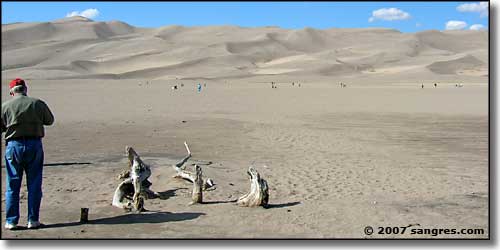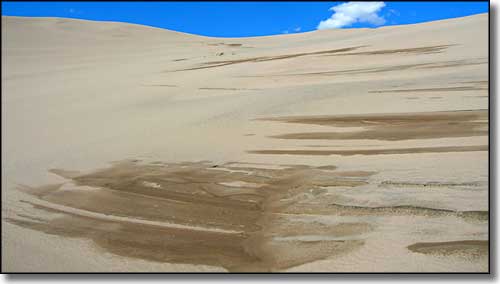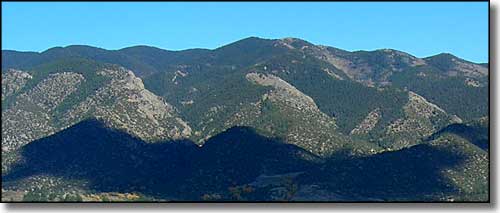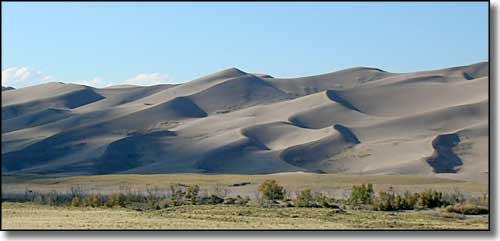
Great Sand Dunes National Park and Preserve Trails

The Great Sand Dunes
Medano Creek Trail - In spring and summer there's water in Medano Creek at the base of the dunes. Everyone seems to enjoy playing in this beach-like environment. As mounds of sand form and fall in the creek bed, a phenomenon called “surge flow” happens, causing an action similar to waves on a sandy beach.
The tallest dunes - While it looks that way from the Visitor Center parking lot, High Dune is not the tallest nor the highest in elevation. High Dune is actually about 650 feet high. To reach it, zigzag up the ridgelines: the 360° view there is truly inspirational. Once you're there, that skyscraping dune to the west is Star Dune, the tallest dune in North America, rising 750 feet above the valley floor. To reach it from High Dune, hike another mile and a half up and down across the dunes to its summit.
Eastern dune ridge - With a high-clearance 4WD vehicle you can drive to the Sand Pit or Castle Creek Picnic Areas. With a 2WD vehicle you'll only make it to Point of No Return and have to hike the next 1/2 mile to Sand Pit. Both areas offer close access to Medano Creek while Castle Creek offers an impressively tall, steep dune face.

Evidence of water saturation near the top of the dunes themselves, close to High Dune
Montville Nature Trail - This is an excellent afternoon hike when you need to escape the heat of the dunes. This is a shady mountain trail named for a late 1800's settlement comprising about 20 houses in its heydey. Near the trail's high point you'll find outstanding views of Mt. Herard, the dunes and the San Luis Valley.
Mosca Pass Trail - This trail winds through aspen and evergreen forests along a small creek in the Sangre de Cristo Mountains.The trail is 3.5 miles one-way, allow 2-3 hours to reach the pass. This was one of the main routes into the San Luis Valley from the east until a mudslide almost blocked it about 100 years ago.
Dunes Overlook/Sand Ramp Trail - The Sand Ramp Trail starts in Loop 2 of Pinon Flats Campground. This trail travels along the foothills of the Sangre de Cristo's and offers exceptional scenery. While it's only a mile to the Dunes Overlook, this trail continues for 10 more miles around the eastern and northern perimeter of the dunes.
Medano Pass 4WD Road - This road requires a high-clearance 4WD vehicle (not recommended for small SUV's). While gorgeous any time of year, this is an especially spectacular drive in the fall. The road is closed when winter conditions create hazards and the creek crossings can be hazardous during spring runoff.

The Sangre de Cristo's between Mosca Pass and Medano Pass
Medano Lake/Mount Herard - This trailhead leaves the Medano Pass 4WD Road at about 10,000' and climbs another 2,000' through lush meadows and forests, ending at Medano Lake, just above timberline. Advanced hikers can continue on to the summit of Mt. Herard (13,297') for an incredible view of the dunes.
Music Pass/Sand Creek Lakes/other alpine peaks - The scenery here is stunning but requires a long drive and/or a long hike. The Music Pass trailhead is accessed from State Highway 69, 4.5 miles south of Westcliffe. Turn to the west at the sign for Music Pass and South Colony Lakes. At the “T” junction, turn left onto South Colony Road. At the end of the ranch fence on the right is another sign for Music Pass. 2WD vehicles should park where the Rainbow Trail crosses the Music Pass Road. It's 3.5 miles from here to the pass. 4WD vehicles may drive another 2.5 rough miles to the end of the road and then hike the steep last mile to the pass. Music Pass is at treeline with a great view of the Upper Sand Creek Basin. From the pass you can access both Sand Creek Lakes and several 13ers rising above the basin. “The Essential Guide to Great Sand Dunes National Park and Preserve,” available in the bookstore, has climbing info for all these peaks.

Getting close to sunset
Great Sand Dunes Index Page - Photo Gallery - Maps - Ongoing Research
Geology FAQ - Great Sand Dunes Partners
